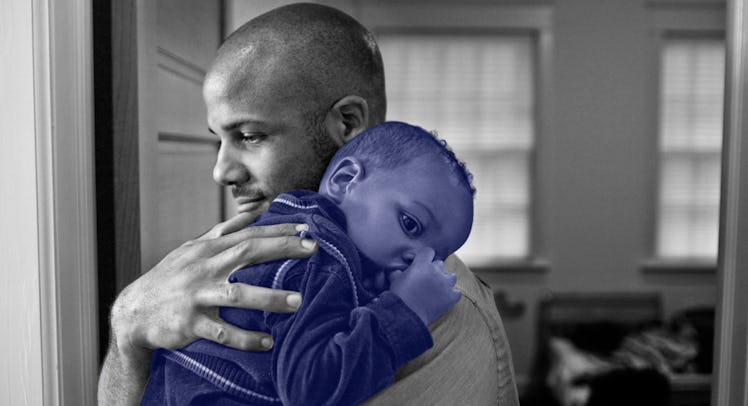How to Carry a Toddler Without Hurting the Kid or Yourself
From baby to toddler, it will help to have the proper carrying equipment and a strong core to protect parents from kid-carrying related injuries.

Sometimes a kid will hustle through a store or park with the confidence and stamina of a marathoner. Then, suddenly, they’ll demand to be picked up, because they just can’t or have come down with rigor mortis or haven’t eaten for fifteen minutes. The utterance of “uppy,” means a parent is sentenced to a seeming eternity of carrying a kid around. Happily, lugging that kind of dead weight around can help cut some flab out of a dad bod. And as a child grows in size, it could even result in some “dad strength.” But, make no mistake, carrying a kid the wrong way can cause some serious, long-term issues for both the kid — dropped kids happen — and the adult, who can win up suffering from chronic back pain, aching shoulders, or bad hips.
Luckily, there’s a humming industry in making durable, transportable, ergonomically designed carrier backpacks. That’s important because gearing up with a solid pack can be a tool in preventing a lifetime of searing back pain directly associated with carrying a child.
“Don’t assume your kid is gonna walk. Prepare,” says Dr. Sabrina Strickland, an orthopedic surgeon at New York’s Hospital for Special Surgery. “Bring the backpack. Bring the stroller so you’re not going to just carry your child for an hour and a half. It’s not good for you. You would never take a 25- or 30-pound dumbbell and rest it on your hip for that long.”
But having a kid carrier, backpack style, doesn’t necessarily mean a guy’s gonna use it right. Particularly if they’re not fond of using the instruction manual. And Strickland stresses that it’s necessary to distribute the weight of a kid correctly in order to keep a body in good alignment and balance.
“We tell school-aged kids to wear a backpack and use both straps, because it can cause back pain and sometimes worsen scoliosis if you’re constantly pulling one shoulder down,” Strickland says. “It’s the same thing when you’re carrying a kid: You want to distribute the weight as much as possible.”
Still, it’s impossible to go everywhere with a backpack or stroller just in case a kid decides to stop walking. It’s even more impractical for parents to constantly wear the appropriate gear around the house. That’s where much of the long-term problems can occur. More often than not, parents are carrying their kids around on their side while multitasking — washing dishes, vacuuming, and other daily chores can become back-breakers when paired with a kid’s weight. It becomes even more damaging if the habituation causes a parent to carry the kid on one side of the body at all times.
How to Carry a Baby or Toddler Without Injury
- Like any good Boy Scout, parents should be prepared with a stroller or baby carrier, because the best way to minimize carrying related injuries is to not carry them at all.
- Follow the instructions on wearable baby carriers to ensure the kid is safe and their weight is distributed on the body correctly.
- Consciously switch sides when carrying a baby on the hip to make sure that your body is balanced.
- A short, simple core exercise routine for 15 minutes every-other-day will help protect from injuries and increase strength.
That all plays into Strickland’s most essential parental advice: When holding a child, parents need to make an effort to switch arms in order to maintain balance and healthy skeletal systems.
“I hear from parents that they always carry their baby on the right, or always on the left. That’s not smart. You really need to alternate and carry the baby on both sides. It sounds so obvious but you’ve got to consciously do it,” says Strickland.
Core strength is another often-overlooked tool that helps parents carry children for long periods. Strickland concedes that it can be difficult for parents to find time to work out, but notes that some good core exercises are crucial. “You can lie on the floor with your kid around you. You don’t have to run to the gym and do a spin class. You can do 5-10 minutes, every-other-day, of some basic core strengthening,” she stresses. “Whether it’s planks or setups or some bridges, there are lots of different workouts. All of us should have good core strength to support our spines, but especially for holding a baby.”
Once a baby becomes a toddler and grows out of the Bjorn, a parent can carry them around without really worrying about whether the method is going to impact the child. Over the shoulder, piggyback, fireman’s carry — if it works for the parent should be fine for the child, provided the parent switches the positioning often enough to minimize damage to their own body.
“Don’t worry about the baby or toddler. Worry about your ability to do what you want to do,” says Strickland. “If you end up having a shoulder problem because you’ve been carrying the baby on one side and now you’re having pain just carrying them, it becomes a big deal.”